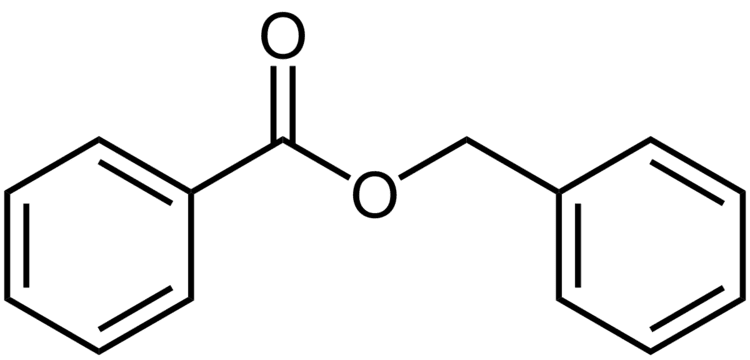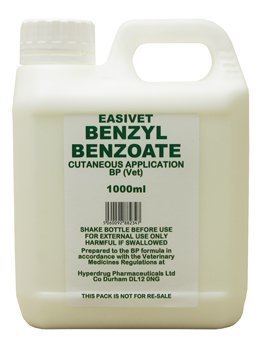CAS Number 120-51-4 DrugBank DB02775 Density 1.12 g/cm³ | PubChem CID 2345 Formula C14H12O2 Molar mass 212.25 g/mol | |
 | ||
Trade names Ascabin, Ascabiol, Ascarbin, Tenutex, others ATC code P03AX01 (WHO) QP53AX11 (WHO) Synonyms benzoic acid phenylmethyl ester, benzy alcohol benzoic ester | ||
Benzyl benzoate (BnBzO), sold under the brand name Scabanca among others, is a medication and insect repellant. As a medication it is used to treat scabies and lice. For scabies either permethrin or malathion is typically preferred. It is applied to the skin as a lotion. Typically two to three applications are needed.
Contents

Side effects may include irritation of the skin. It is not recommended in children. It is also used in other animals; however, is toxic to cats. How it works is unclear.
Benzyl benzoate was first studied medically in 1918. It is on the World Health Organization's List of Essential Medicines, the most important medication needeIt is on the World Health Organization's List of Essential Medicines, the most effective and safe medicines needed in a health system. Benzyl benzoate is available as a generic medication. The wholesale cost in the developing world is about 0.21 to 0.53 USD per 100 mls. It is not available for medical use in the United States. In the United Kingdom it costs the NHS about 2.50 pounds for 500 mLs.

Benzyl benzoate
Medical

Benzyl benzoate is an effective and inexpensive topical treatment for human scabies. It has vasodilating and spasmolytic effects and is present in many asthma and whooping cough drugs. It is also used as an excipient in some testosterone-replacement medications (like Nebido) for treating hypogonadism.
Benzyl benzoate is used as a topical acaricide, scabicide, and pediculicide in veterinary hospitals.
Non-medical

Benzyl benzoate is used as a repellent for chiggers, ticks, and mosquitoes. It is also used as a dye carrier, solvent for cellulose derivatives, plasticizer, and fixative in the perfume industry.
Side effects
Benzyl benzoate has low acute toxicity in laboratory animals. It is rapidly hydrolyzed to benzoic acid and benzyl alcohol. Benzyl alcohol is subsequently metabolized to benzoic acid. The conjugates of benzoic acid are rapidly eliminated in urine. When given in large doses to laboratory animals, benzyl benzoate can cause hyperexcitation, loss of coordination, ataxia, convulsions, and respiratory paralysis.
Benzyl benzoate can be a skin irritant when used as a topical scabicide. Overdose can result in blistering and hives or a rash can occur as an allergic reaction.
As an excipient in some testosterone-replacement injectable medications, benzyl benzoate has been reported as a cause of anaphylaxis in a case in Australia. Bayer includes this report in information for health professionals and recommends that physicians "should be aware of the potential for serious allergic reactions" to preparations of this type. In Australia, reports to ADRAC, which evaluates reports of adverse drug reactions for the Therapeutic Goods Administration, show several reports of allergic issues since the anaphylaxis case from 2011.
Chemistry
It is an organic compound with the formula C6H5CH2O2CC6H5. It is the ester of benzyl alcohol and benzoic acid. It forms either a viscous liquid or solid flakes and has a weak, sweet-balsamic odor. It occurs in a number of blossoms (e. g. tuberose, hyacinth) and is a component of Balsam of Peru and Tolu balsam.
Production
Benzyl benzoate is produced industrially by the reaction of sodium benzoate with benzyl alcohol in the presence of a base, or by transesterification of methyl benzoate and benzyl alcohol. It is a byproduct of benzoic acid synthesis by toluene oxidation. It can also be synthesized by the Tishchenko reaction, using benzaldehyde with sodium benzylate (generated from sodium and benzyl alcohol) as catalyst:
